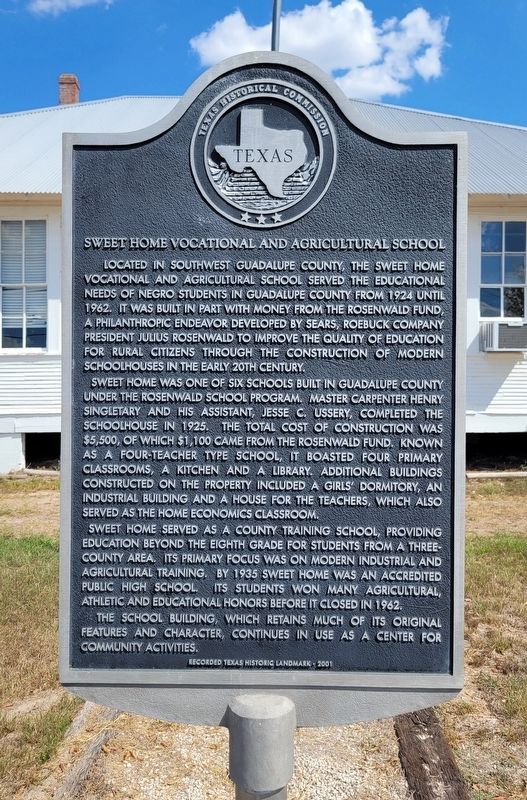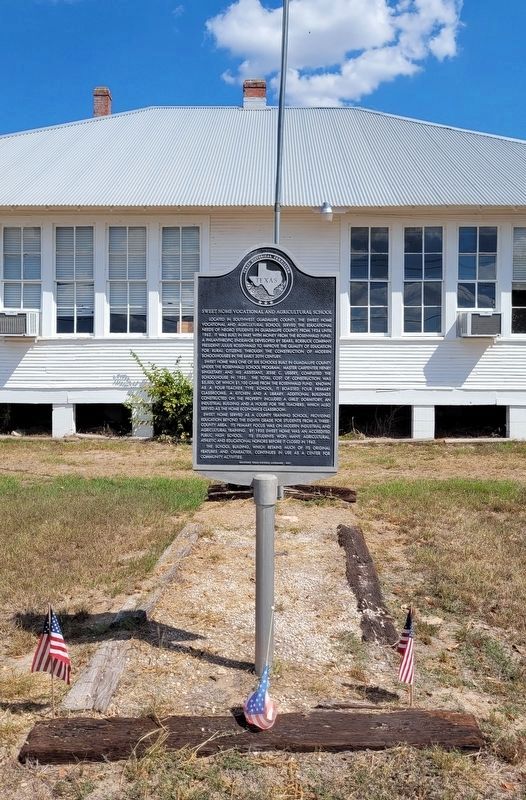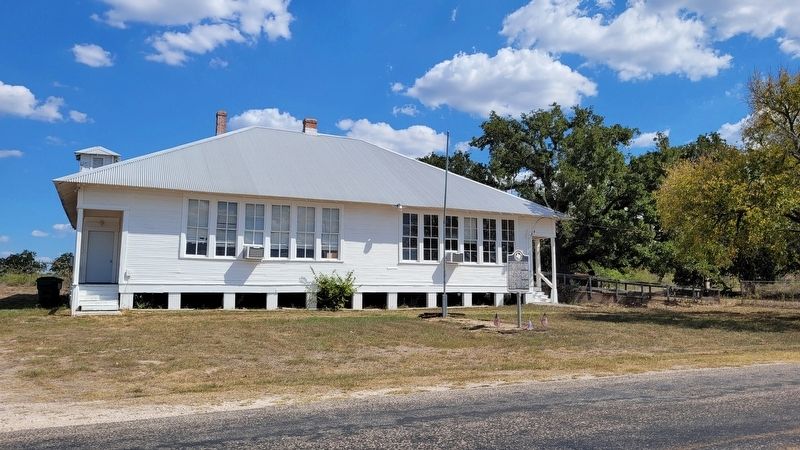Near Seguin in Guadalupe County, Texas — The American South (West South Central)
Sweet Home Vocational and Agricultural School
Inscription.
Located in southwest Guadalupe County, the Sweet Home Vocational and Agricultural School served the educational needs of Negro students in Guadalupe County from 1924 until 1962. It was built in part with money from the Rosenwald Fund, a philanthropic endeavor developed by Sears, Roebuck Company president Julius Rosenwald to improve the quality of education for rural citizens through the construction of modern schoolhouses in the early 20th century.
Sweet Home was one of six schools built in Guadalupe County under the Rosenwald School Program. Master carpenter Henry Singletary and his assistant, Jesse C. Ussery, completed the schoolhouse in 1925. The total cost of construction was $5,500, of which $1,100 came from the Rosenwald Fund. Known as a four-teacher type school, it boasted four primary classrooms, a kitchen and a library. Additional buildings constructed on the property included a girls dormitory, an industrial building and a house for the teachers, which also served as the home economics classroom.
Sweet Home served as a county training school, providing education beyond the eighth grade for students from a three county area. Its primary focus was on modern industrial and agricultural training. By 1935 Sweet Home was an accredited public high school. Its students won many agricultural, athletic and educational honors before it closed in 1962. The school building, which retains much of its original features and character, continues in use as a center for community activities.
Erected 2001 by Texas Historical Commission. (Marker Number 12565.)
Topics. This historical marker is listed in these topic lists: African Americans • Agriculture • Education. A significant historical year for this entry is 1924.
Location. 29° 27.667′ N, 98° 2.352′ W. Marker is near Seguin, Texas, in Guadalupe County. Marker is on Sweet Home Road (County Highway 409) near Settlers Way (County Highway 411B), on the left when traveling south. The marker is located in front of the school building. Touch for map. Marker is at or near this postal address: 3340 Sweet Home Road, Seguin TX 78155, United States of America. Touch for directions.
Other nearby markers. At least 8 other markers are within 7 miles of this marker, measured as the crow flies. Christ Lutheran Church of Elm Creek (approx. 2.7 miles away); To All Veterans (approx. 3˝ miles away); Warncke Cemetery (approx. 3˝ miles away); Post Oak Community Cemetery (approx. 3.7 miles away); Site of Muelder Store (approx. 3.8 miles away); Boecker Cemetery (approx. 4 miles away); Dugger Cemetery (approx. 6 miles away); Concrete Cemetery (approx. 6.6 miles away). Touch for a list and map of all markers in Seguin.
Also see . . . Rosenwald Schools in Texas. Texas Historical Commission
In 1917, Julius Rosenwald, president of Sears, Roebuck and Co. of Chicago, established the Julius Rosenwald Fund to support the construction of schools for African-American children in the southern United States. Between 1920 and 1932, the program donated more than $28 million in fifteen states, and resulted in 527 funded buildings on approximately 466 school campuses in Texas.(Submitted on October 10, 2022, by James Hulse of Medina, Texas.)
Rosenwald Schools represent an important chapter in Texas history, reflecting the initiative of African-American communities which sought educational opportunities for their children during the Jim Crow Era, when all public schools in Texas were segregated by law. With financial assistance from the Rosenwald Fund, these communities built modern school facilities, many of which continued to operate as schools into the 1960s. Most Rosenwald buildings were built of wood following standardized plans, and many were demolished after they ceased serving as schools, while a few were converted to churches or community centers. Some communities built teacherages (teacher’s homes) and related buildings with Rosenwald assistance.
Credits. This page was last revised on October 10, 2022. It was originally submitted on October 10, 2022, by James Hulse of Medina, Texas. This page has been viewed 360 times since then and 28 times this year. Photos: 1, 2, 3. submitted on October 10, 2022, by James Hulse of Medina, Texas.


